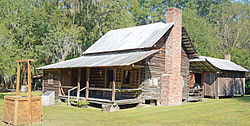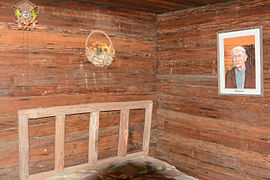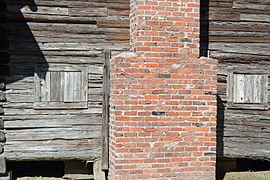
The Franklin Pierce Homestead is a historic house museum and state park located in Hillsborough, New Hampshire. It was the childhood home of the fourteenth president of the United States, Franklin Pierce.

The King Store and Homestead are historic buildings located at 209 and 211 Main Street, in the Ledgewood section of Roxbury Township, in Morris County, New Jersey, United States. The Roxbury Historic Trust acts as curator for these Roxbury Township-owned buildings. They were purchased by the Township with Green Acres funding. The buildings were added to the National Register of Historic Places on April 29, 1994, for their significance in commerce from 1815 to 1928. Both were later added as contributing properties to the Ledgewood Historic District on April 18, 2013.
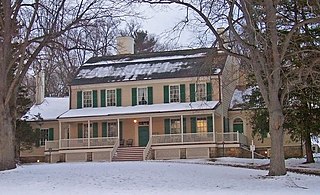
The John Jay Homestead State Historic Site is located at 400 Jay Street in Katonah, New York. The site preserves the 1787 home of statesman John Jay (1745–1829), one of the three authors of The Federalist Papers and the first Chief Justice of the United States. The property was designated a National Historic Landmark in 1981 for its association with Jay. The house is open year-round for tours.
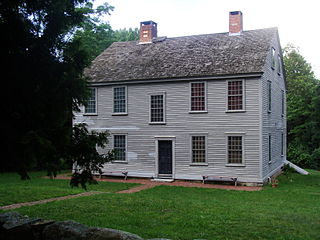
The General Nathanael Greene Homestead, also known as Spell Hall, is a historic house at 20 Taft Street in Coventry, Rhode Island. It was the home of American Revolutionary War general Nathanael Greene from 1770 to 1776, and was owned afterwards by his brother Jacob Greene and his wife Margaret. The house is owned and operated by the General Nathanael Greene Homestead Association, a non-profit organization, and was opened as a museum in 1924.

Maybury Hill is a historic house at 346 Snowden Lane, in Princeton, Mercer County, New Jersey, United States. Built about 1725, it was the birthplace and boyhood home of Joseph Hewes (1730-1799), a signer of the United States Declaration of Independence. The house, an architecturally excellent example of Georgian domestic architecture, was designated a National Historic Landmark in 1971 for its association with Hewes. It is a private residence not open to the public.

The Reynolds Homestead, also known as Rock Spring Plantation, is a slave plantation turned historical site on Homestead Lane in Critz, Virginia. First developed in 1814 by slaveowner Abraham Reynolds, it was the primary home of R. J. Reynolds (1850-1918), slaveowner, founder of the R. J. Reynolds Tobacco Company, and the first major marketer of the cigarette. Upon liberation of the plantation in 1863, 88 people were freed from captivity and enslavement. It was later designated a National Historic Landmark in 1977. The homestead is currently an outreach facility of Virginia Tech, serving as a regional cultural center. The house is open for tours.

The Dodge-Greenleaf House is on NY 211 in Otisville, New York, United States. It was built circa 1855 in the Gothic Revival style. The architect is unknown but it exemplifies contemporary trends in home design popularized by the writings and pattern books of Andrew Jackson Downing of nearby Newburgh, as articulated in the Picturesque mode.

The Abbot-Stinson House is a historic house in Andover, Massachusetts. The house is estimated to have been built in the early 1720s, in the transitional period between First Period and Georgian styles of construction. It was originally one room deep with a central chimney, but was extended by additions to the rear in the 20th century. The house was listed on the National Register of Historic Places in 1990.

The Daniel Nichols Homestead is a historic home in Reading, Massachusetts. The oldest portion of this timber-frame house was built in the early 1740, with vernacular Georgian styling. The house is five bays wide and two deep, with a rear shed-roof extension giving the house a saltbox appearance. An ell was added in the mid-19th century. The main architectural detail is the front door surround, which features sidelight windows and recessed, paneled pilasters supporting a tall entablature.
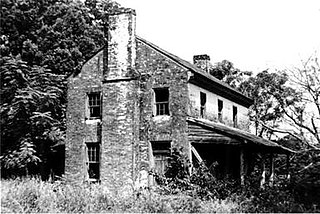
The McGehee–Stringfellow House, also known as Oak Grove, was a historic plantation house near Greensboro, Alabama, United States. It was added to the National Register of Historic Places on September 17, 1980, due to its architectural significance. It was accidentally destroyed in the 1980s during an attempt to move it to another location.

The Roseberry Homestead, also known as the Walter Gess House, is a classic Georgian house, erected of rough-cut quarry stone between 1765 and 1783 in Phillipsburg, Warren County, New Jersey, United States. It is a 2+1⁄2-story, five-bay plan house, two rooms deep, with a center through hall. There is an attached 1+1⁄2-story stone kitchen, probably built before the main house. There are three chimneys—two rising from the gable ends of the main block, and the third from the gable end of the kitchen. There is a large cooking fireplace in the kitchen, with a removed brick oven. A winder stair on the fireplace wall leads to the loft above. The front of the house is on the downhill side, allowing for a walk-in cellar. A porch extended across the entire front, permitting access to the higher level first floor, but that has long since disappeared. John Roseberry, Sr. was one of the original settlers in Phillipsburg. It is very likely the oldest existing structure in town.
Barber House, Barber Farm, or Barber Barn may refer to:

Kemmerer House, also known as the Mr. & Mrs. Russell L. Pellett Residence and Irongate, is a historic home located in Emmaus, Pennsylvania, in the United States. It was built between 1840 and 1850 and is a two-story, masonry dwelling with Georgian style influences. It has a five bay wide front facade. Also on the property is a Pennsylvania-German forbay barn.

Andreas Rieth Homestead is a historic home located near Pennsburg at Marlborough Township, Montgomery County, Pennsylvania. The property has two contributing buildings. The Rieth Farmhouse is a 2+1⁄2-story, stone dwelling originally built in the Germanic style, but later modified to a Georgian plan. It has a rear kitchen addition. Also on the property is a former 1/2-story, stone bank house later converted to a bank barn.
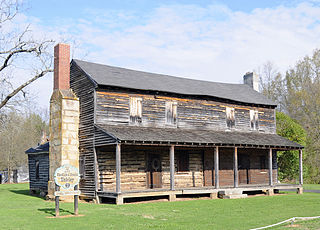
The Obediah Shirley House, sometimes referred to as the Obediah and Jennie Shirley Home is a historic farmhouse with a fieldstone foundation, located near Honea Path, South Carolina. Its construction was completed in several phases in order to accommodate the Shirley family as their family grew in number. The original, one-story log cabin was built in 1826 with the second-floor and two rooms to the north added before 1850. After 1850, a third room was added to the house, which increased the width. The front porch and kitchen were added in later in the 19th century.

The John Watson House, also known as the Intervale Farm, is a historic house on Benny Babb Hill Road in Hiram, Maine. Built in 1785 by one of Hiram's first settlers, it is now the oldest building in the town, and is a well-preserved example of late Georgian architecture. It was listed on the National Register of Historic Places in 1974.

The Hofwyl-Broadfield Plantation was a plantation on the Altamaha River, in Glynn County, Georgia. Operated as a forced-labor farm until 1865, it produced rice from 1800 until 1915, when growing rice became unprofitable. Then it was primarily a dairy farm until 1942.

The Ethan Allen Homestead is a historic house museum at 1 Ethan Allen Homestead in Burlington, Vermont. It was built about 1787 by Ethan Allen, and is the only surviving residence of his in the state. It is open to the public annually from May to October. It was listed on the National Register of Historic Places in 1986.

The Solomon Goodrich Homestead is a historic house at 4787 Ethan Allen Highway in Georgia, Vermont. With its oldest section dating to the late 1780s, it is one of the community's oldest surviving buildings. Its later and more prominent brick front is a good early example of Federal period architecture. The house was listed on the National Register of Historic Places in 2004.

Culwalla Homestead is a heritage-listed former dairy farm and now residence located 2km east of Jamberoo Main Road, Jamberoo, Municipality of Kiama, New South Wales, Australia. It was built in 1858 by James Marks. It was added to the New South Wales State Heritage Register on 2 April 1999.
